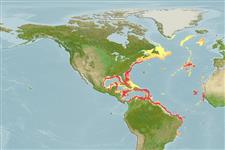>
Gadiformes (Cods) >
Macrouridae (Grenadiers or rattails)
Etymology: Coelorinchus: Greek, koilos = a hollow + Greek, rhyngchos = jaw (Ref. 45335).
More on author: Risso.
Environment: milieu / climate zone / depth range / distribution range
Ekologi
laut bentopelagis; nir-ruaya; kisaran kedalaman 90 - 1485 m (Ref. 104125), usually 200 - 500 m (Ref. 1371). Deep-water; 62°N - 18°S, 98°W - 17°W (Ref. 1371)
Northeast Atlantic and Mediterranean Sea. A loose sort of southern limit for Caelorinchus caelorhincus caelorhincus is probably around Cape Verde; most specimens south and to the east into the Gulf of Guinea are likely to be Caelorinchus caelorhincus geronimoi (Iwamoto 1997, pers. Comm.). Northwest Atlantic: Canada (Ref. 5951).
Size / Weight / umur
Maturity: Lm ? range ? - ? cm
Max length : 48.0 cm TL jantan/; (Ref. 5951); common length : 30.0 cm TL jantan/; (Ref. 2683); Umur maksimum dilaporkan: 10 Tahun (Ref. 58045)
Duri punggung (Keseluruhan (total)): 0; Duri dubur 0. Eyes large; snout short, moderately pointed, its anterolateral margin incompletely supported by bone. Head ridges strong but with rather fine spinules; terminal snout scute trifid, wider than long, small and blunt to large and pointed, with a terminal and two lateral arms of about equal size. Underside of the snout naked medially. Light organ large, a black naked fossa between and slightly anterior to the pelvic fin bases. Overall color is pale grayish-brown to swarthy, with a series of broad saddle marks in some; oral cavity pale to dark (Ref. 1371). Spiny fin ray of first dorsal fin with a smooth and rounded leading edge (Ref. 35388).
Found commonly in about 200-500 m. Feeds on a variety of benthic organisms, such as polychaetes, gastropods, cephalopods, numerous crustacean groups (copepods, gammarians, isopods, cumaceans, Natantia) and fish. Minimum depth range taken from Ref. 1371.
Life cycle and mating behavior
Kematangan | Reproduksi, perkembang biakan | Pemijahan | telur-telur | Fecundity | Larva
Cohen, D.M., T. Inada, T. Iwamoto and N. Scialabba, 1990. FAO species catalogue. Vol. 10. Gadiform fishes of the world (Order Gadiformes). An annotated and illustrated catalogue of cods, hakes, grenadiers and other gadiform fishes known to date. FAO Fish. Synop. 125(10). Rome: FAO. 442 p. (Ref. 1371)
Status IUCN Red List (Ref. 130435)
ancaman kepada manusia
Harmless
penggunaan manusia
Perikanan: nilai komersial kecil
informasi lanjut
AcuanBudidaya airprofil budidaya airStrainGenetikaElectrophoresesDiturunkanPenyakit-penyakitPengolahanNutrientsMass conversion
Alat, peralatan
laporan khas
muat turun XML
Sumber internet
Estimates based on models
Preferred temperature (Ref.
123201): 8.6 - 19.6, mean 13.2 °C (based on 160 cells).
Phylogenetic diversity index (Ref.
82804): PD
50 = 0.5000 [Uniqueness, from 0.5 = low to 2.0 = high].
Bayesian length-weight: a=0.00191 (0.00158 - 0.00230), b=3.15 (3.10 - 3.20), in cm total length, based on LWR estimates for this species (Ref.
93245).
Trophic level (Ref.
69278): 3.5 ±0.2 se; based on diet studies.
Generation time: 8.5 ( na - na) years. Estimated as median ln(3)/K based on 2
growth studies.
Daya lenting (Ref.
120179): Rendah, Waktu penggandaan populasi minimum 4.5 - 14 tahun (K=0.13-0.15; tmax=8).
Fishing Vulnerability (Ref.
59153): High vulnerability (60 of 100).
Nutrients (Ref.
124155): Calcium = 16.7 [8.0, 38.2] mg/100g; Iron = 0.302 [0.148, 0.621] mg/100g; Protein = 15.4 [13.3, 17.9] %; Omega3 = 0.222 [0.093, 0.498] g/100g; Selenium = 25.6 [9.1, 65.5] μg/100g; VitaminA = 17.1 [3.3, 84.4] μg/100g; Zinc = 0.495 [0.309, 0.805] mg/100g (wet weight);
